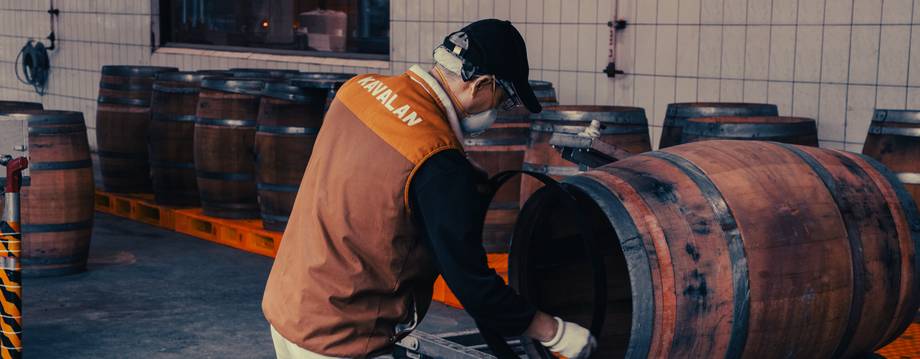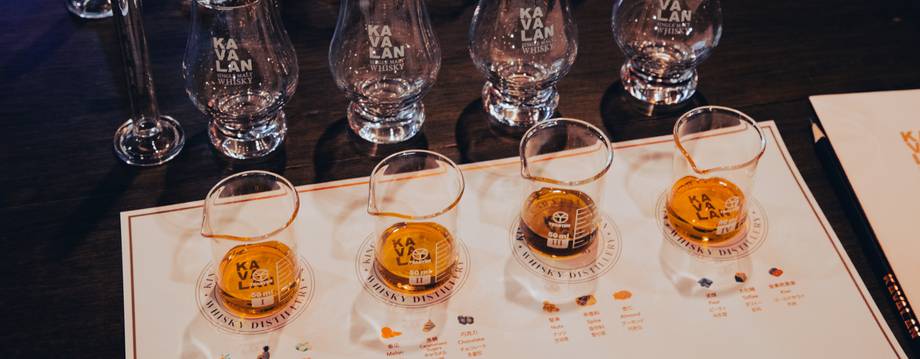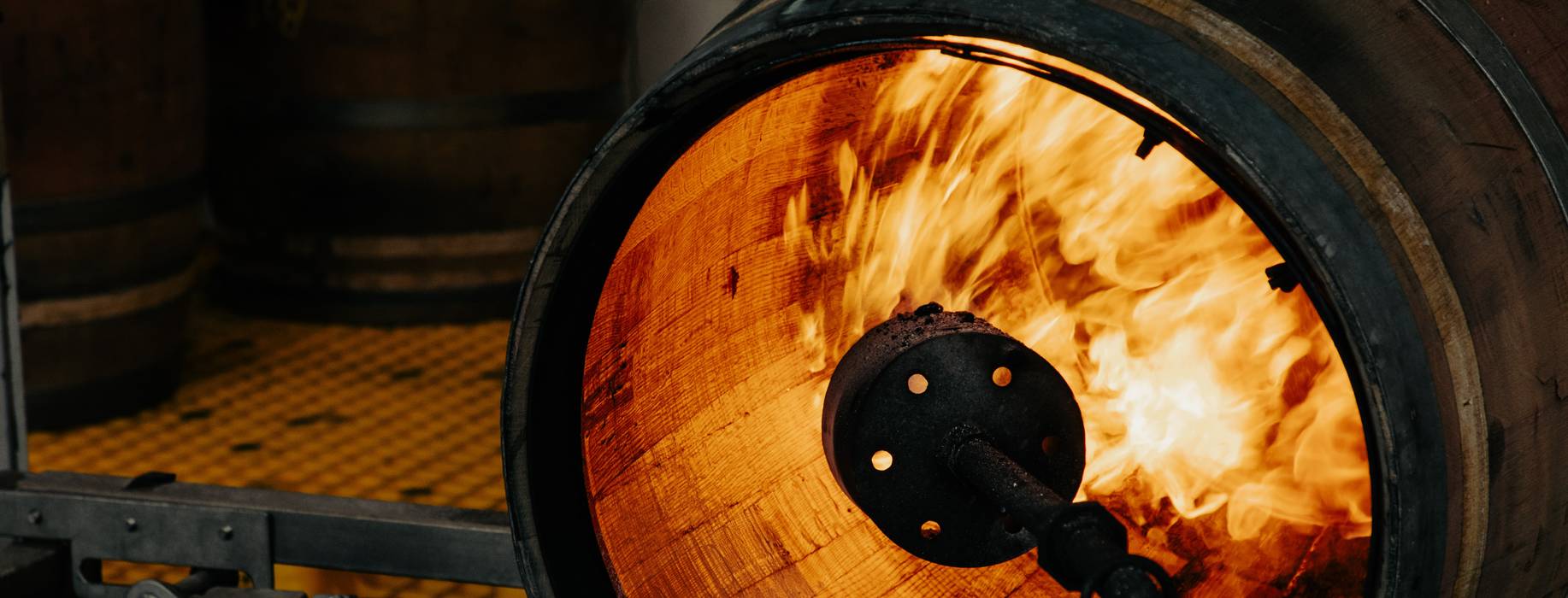Fire in the belly
From obscure to ubiquitous, Kavalan distillery launched Taiwanese whisky into global superstardom
Robyn Gilmour
Photos:
Doug Wilson Garry
Saturday 31 May 2025

This article is from
Taiwan
issue 118
Share this article
It rains in Yilan for just over two thirds of the year. Cut off from the rest of the island by the Xueshan and Central Mountain Range, the county is a vast, flat plain, pressed against the sea and punctuated by alluvial fans running into the Lanyang River. Before it was called Yilan, the region was named after the indigenous people that made their home there; Kavalan means ‘flatland people’ or ‘people living in the plain’.
Like all distilleries, your introduction to Kavalan whisky begins long before you reach the point of its production. An hour and half’s drive from Taipei, you leave all traces of the city behind when you enter the Hsuehshan Tunnel; 12 kilometers of road through solid mountain. When you emerge, there is usually rain, or mist at the very least. The peaks of the mountains behind you are snow-capped, depending on the time of year. This rain and meltwater filters through the mountain's bedrock, emerging in springs from which the distillery draws for its production.
While it’s by no means the only unique feature of the spirit produced at Kavalan, global brand ambassador Britney Chen says that the distillery’s water supply is a big part of what gives its whisky such a distinctive character. “The mountains preserve that rain and melting snow in a really amazing way,” she says. “The water is filtered and becomes really mineral-rich, making it the perfect carrier for the kinds of expressions we want to bring — that’s mostly of tropical fruit like pineapple, mangos, and sometimes bananas. I also think the water imparts a subtle sweetness that makes it extra smooth and really easy to drink.”
The fickle Taiwanese climate also plays a huge role in shaping its whisky, from field to bottle. Taiwan can and does grow barley, but with typhoons being commonplace, it's an unreliable crop. As such, Kavalan imports all its barley from Scandinavia.
Additionally, the challenge posed by humidity cannot be overstated. In the summer Yilan is sweltering hot, and the rest of the year, humidity fluctuates with the weather, which ranges from mild and misty to outright cold. “Sometimes we’re tempted to call it the devil’s share, instead of the angel’s share” says Britney, referring to the portion of alcohol lost from the maturing whisky through evaporation, something greatly influenced by fluctuations in temperature and humidity.

To mitigate evaporation as much as possible, filled casks are racked ten high across what looks more like a vault in the British Library than a barrel store, to encourage air flow. Britney points out that batches of barrels are all securely fastened together to avoid collapse in the event of earthquakes. In this context, it becomes apparent how extreme an environment Taiwan is for making whisky.
And yet, this environment is precisely what imbues Kavalan with such unique characteristics. The same humidity that results in such a significant angel’s share, means Taiwanese whisky matures at a much more rapid rate than its international counterparts.
After two years, Kavalan’s whisky is already a deep colour, rich with flavour from the barrel it's been aged in. Britney says that although they’re only technically required to age the spirit for two years, in order to comply and compete with international standards Kavalan allows its whisky to mature for a minimum of four years. She says that the longer exposure to fluctuating temperatures does something to the whisky that one can’t quite put their finger on, but that the technical team unanimously regard as having a positive influence on the end product.
Where nature’s influence ends and human intervention begins, Kavalan whisky becomes even more interesting. The distillery operates primarily across wine barriques and sherry casks, but takes an innovative and resourceful approach to barrel use and management. When barriques arrive at the distillery, age and condition varies from barrel to barrel, and so to ensure a consistent starting point for all its whisky, the inside of the barrel is shaved — bringing it back to its base wood — then toasted — to evoke the wood’s gentle vanilla notes — and finally scorched — bringing a rich caramel flavour to the whisky aged therein.
This process, officially called the STR cask rejuvenation process, was invented by the late Dr James (Jim) Swan, a Scottish chemist revered in the world of whisky for his work as a consultant, blender and master distiller at the likes of the Nc'nean, Clydesdale, Lindores Abbey and Kilchoman distilleries, and for helping to set up distilleries in Bangalore, Tel Aviv, and British Columbia. I daresay Kavalan was the jewel in his crown, a distillery which embraced unique challenges to produce a unique spirit under the watchful supervision of master blender Ian Chang.
Together, Swan and Chang took Kavalan from unknown to untouchable in the whisky world, first winning the ‘World's Best Single Malt’ award from the World Whiskies Awards in 2015 for its Solist Vinho Barrique, and then solidifying its status among legends of the whisky world with its 2016 Best Single Malt Single Cask at the same awards for its Solist Amontillado Sherry Single Cask Strength. Dr Swan passed away in 2017 at the age of 75, and Ian Chang left Kavalan in 2020 for a new venture in Japan.

Aside from the difficulty of managing climate, protecting against earthquakes, and sourcing materials from half way across the world, the challenge that almost stopped Kavalan before it could get started was the fact that no one believed whisky could be made in Taiwan. The climate was far too intense, and unpredictable.
When the King Car Group, the distillery’s parent company, first established itself as a drinks business in 1979, martial law was in operation across Taiwan and the government was the only entity permitted to produce alcohol. As such, King Car originally produced and traded in coffee, sodas and functional beverages, but the company’s founder, Mr. T.T. Lee had a taste for Glenlivet and dreamed of a day when he could incorporate distilling into the King Car Portfolio.
Interestingly, that day arrived not with the end of martial law, but in 2005, three years after Taiwan joined the World Trade Organisation. “Whisky was a better product for us to build a bridge with,” says Britney. “Here in Taiwan, we have another popular spirit called Gaoliang, but if I offered you a glass of that, you might think twice because it's unfamiliar. Whisky is recognisable, and therefore more approachable.”
Yet in spite of Kavalan’s success on the international stage, it still has hearts and minds to win at home where, in truth, not a whole lot of alcohol is consumed. Britney says the Taiwanese palate is primed to enjoy whisky, with the prevalence of tea acquainting people with the subtle flavours that make a whisky shine. “People also really understand how to taste here,” she says. “They know that when they drink tea, they’ll get the flavour and texture, but if they wait a moment before taking another sip, sweetness will follow and the mouthfeel might change.”
That there is work to do domestically has not deterred Kavalan from throwing itself into the challenge of connecting with Taiwanese people. The distillery is enormous and incredibly beautiful, with tours and the on-site education centre being free to attend by anyone interested. Britney says that you don’t have to enjoy whisky to visit Kavalan; Mr. Brown Coffee, a truly impressive coffee roastery that’s a sister to Kavalan within the King Car portfolio, enjoys an elegant on-site cafe for any visitors who might prefer a coffee after their tour. The whisky, however, is never out of sight, so if visitors feel brave at any point, there’s an opportunity to try Kavalan, and get a taste of what Taiwanese whisky can be.
Share this article

